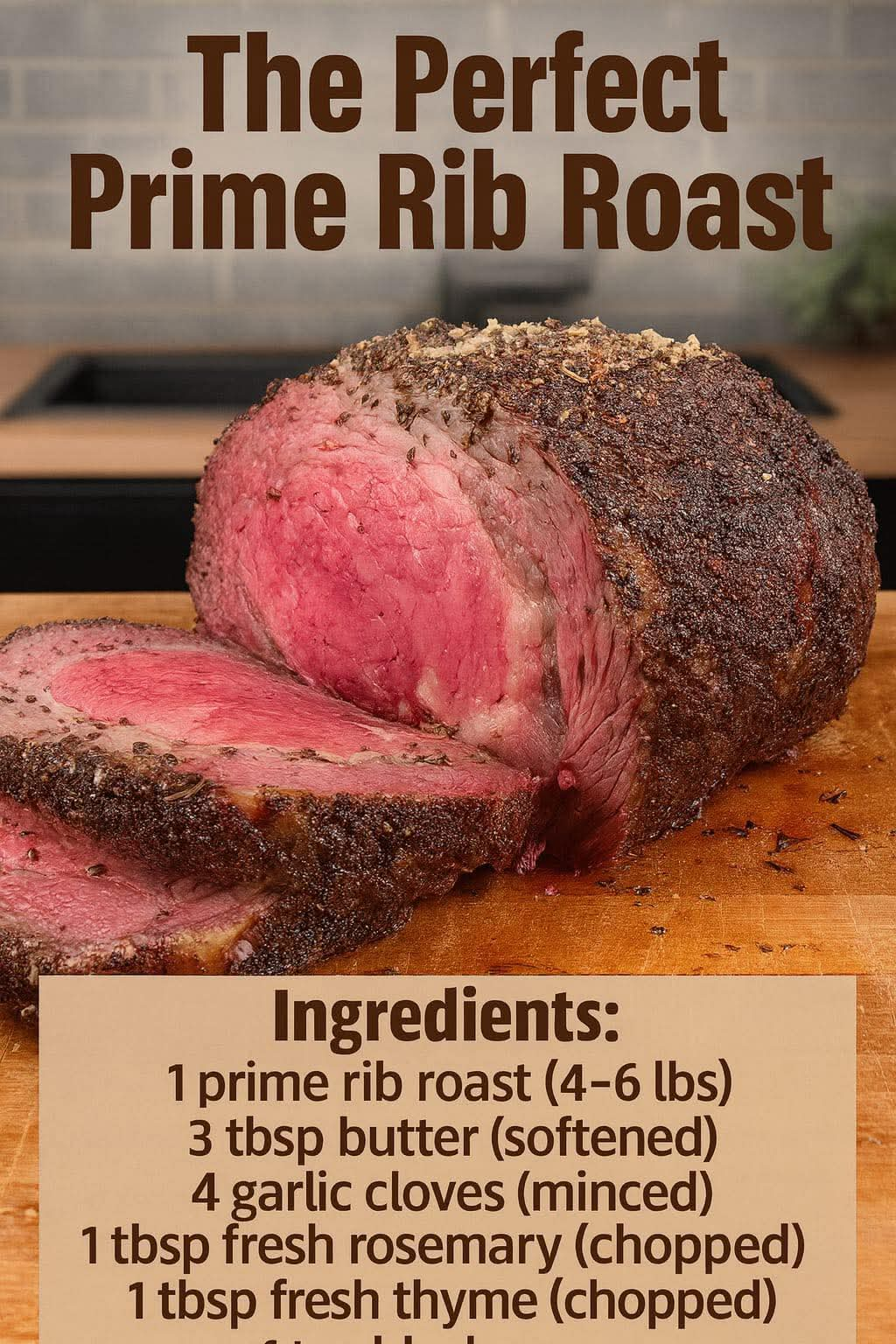Here is a big, rich, complete Prime Rib Roast recipe, including introduction, history, ingredients, method, formation, conclusion, and even a fun “lovers” section (celebrating people who adore this dish).
Enjoy this fully expanded version! 🍽️🔥
🥩🔥 THE PERFECT PRIME RIB ROAST — A GRAND, FULL RECIPE ✨
⭐ INTRODUCTION
Prime rib is often called the king of roasts—a centerpiece dish known for its tenderness, marbling, and unforgettable flavor. For centuries, this majestic cut has graced holiday tables, celebration feasts, and Sunday dinners meant to impress.
With its luscious crust, garlic-herb aroma, and juicy, rosy interior, prime rib stands at the crossroads of tradition, luxury, and pure comfort.
This recipe gives you everything: classic technique, culinary history, step-by-step methods, special tips, and even a heartfelt tribute to the people who love prime rib the most.
🥩 INGREDIENTS
For the Roast
- 1 prime rib roast, 4–6 lbs (bone-in preferred for best flavor)
- 3 tbsp unsalted butter, softened
- 4 cloves garlic, minced
- 1 tbsp fresh rosemary, finely chopped
- 1 tbsp fresh thyme, chopped
- 1 tbsp kosher salt
- 1 tsp black pepper, freshly cracked
- 1 tsp smoked paprika (optional, for deeper color)
- 1–2 tbsp olive oil
Optional Aromatics (for roasting pan)
- 1 large onion, quartered
- 2 carrots, chopped
- 2 celery stalks, chopped
- 1 cup beef broth (for drippings or gravy)
📜 A SHORT HISTORY OF PRIME RIB
Prime rib, also known as “standing rib roast,” dates back to the 18th and 19th centuries in England, where roasting became a defining cooking method for large joints of meat. The aristocracy favored large cuts cooked slowly over a hearth, producing a tender, richly flavored centerpiece.
In America, prime rib surged in popularity in the early 20th century, becoming the hallmark of steakhouses, holiday gatherings, and festive feasts. Its name “prime” refers not only to quality but to its prime location along the rib primal—one of the most treasured sections of beef.
Today, the dish remains a symbol of celebration, craftsmanship, and culinary indulgence.
🧪 FORMATION OF FLAVOR (Culinary Science)
What makes prime rib unforgettable?
- Marbling melts into the meat during roasting, creating exceptional juiciness.
- Slow roasting ensures even cooking and a tender, medium-rare interior.
- Herb-butter crusting promotes the Maillard reaction—the browning that delivers deep, roasted flavor.
- Bone-in structure adds insulation and enhances meat richness.
This combination results in a perfectly balanced, richly flavored roast with a crackling crust and buttery interior.
👨🍳🔥 FULL METHOD & STEP-BY-STEP INSTRUCTIONS
⭐ 1. Prepare the Roast
- Bring the roast to room temperature for 2 hours before cooking.
- Pat dry with paper towels.
- Mix butter, garlic, rosemary, thyme, salt, pepper, paprika, and olive oil into a paste.
- Rub the mixture generously over the entire roast.
⭐ 2. Set Up the Roasting Pan
- Place onions, carrots, and celery on the bottom (optional).
- Set the roast bone side down, fat side up—like a natural roasting rack.
⭐ 3. Searing Roast (Optional but Flavorful)
- Preheat oven to 450°F (230°C).
- Roast at this high heat for 15 minutes to form a crust.
⭐ 4. Slow Roasting
- Reduce heat to 325°F (165°C).
- Continue roasting:
- 20–25 min per pound for medium-rare
- 25–30 min per pound for medium
- Use a thermometer:
- 125°F (52°C) = rare
- 135°F (57°C) = medium-rare
- 145°F (63°C) = medium
⭐ 5. Resting
- Remove from oven and tent loosely with foil.
- Rest 20–30 minutes.
- This allows juices to redistribute for maximum tenderness.
⭐ 6. Carving
- Slice along the bones to remove the rack.
- Carve thick, even slices—about ¾ to 1 inch.
❤️ FOR THE LOVERS (Those Who Cherish Prime Rib)
This roast is especially beloved by:
- Holiday hosts who want to wow their guests
- Meat enthusiasts who appreciate marbling and tenderness
- Romantics planning a cozy, candlelit dinner
- Chefs & cooks who love the artistry of slow roasting
- Families looking to create traditions that last for generations
Prime rib lovers know:
This is more than a dish—it’s an experience shared around a warm table.
🧑🍳 CHEF’S EXTRA METHODS (Bonus Techniques)
Reverse Sear Method
- Cook at 250°F until internal temp hits 120°F.
- Rest the roast.
- Blast at 500°F for 10 minutes for a crispy finish.
Herb-Crust Method
- Add crushed peppercorns and coarse salt
- Press fresh herbs firmly into the butter coat
- Creates an incredibly aromatic crust
Bone-in Dry Aging Method (Advanced)
- Store uncovered in the fridge for 3–5 days
- Enhances meat flavor and surface browning
🎉 CONCLUSION
The perfect prime rib roast is a masterpiece of texture, aroma, and flavor—a dish steeped in tradition, culinary science, and celebration. Whether you’re preparing it for a holiday, a special weekend, or a romantic feast for two, this roast delivers elegance and comfort in every slice.
Prime rib is not just cooked…
It’s crafted, shared, and loved.
